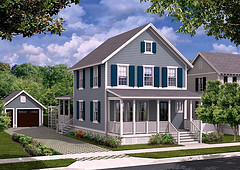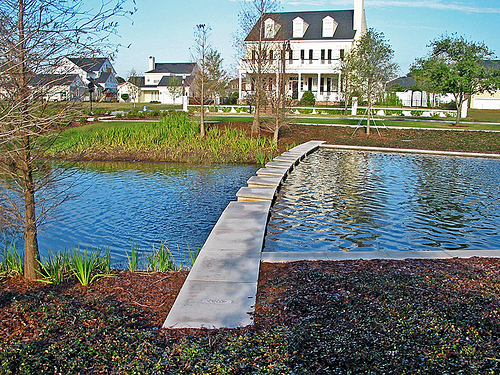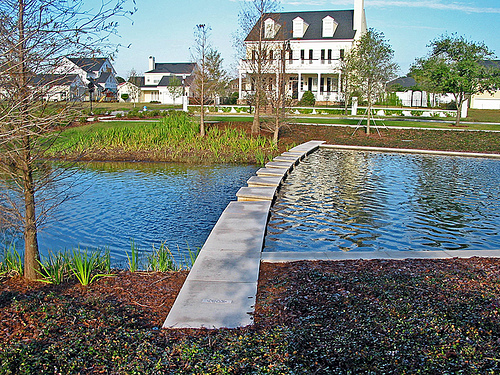 A rendering of what the New Economy Home might look like.Cross-posted from the Natural Resources Defense Council.
A rendering of what the New Economy Home might look like.Cross-posted from the Natural Resources Defense Council.
The median size of a new single-family home in the U.S. was around 2,300 square feet in 2007, and crept up to around 2,500 by 2008. But today, the median home size has dropped to 2,100 square feet, writes Cindy Perlman in USA Today.
Are McMansions going the way of the Hummer? Not entirely, I suspect, but I do think demand for them is dropping, as the numbers suggest.
Another indication that Americans are getting a bit more sensible is that the industry magazine Builder, which annually features a concept home at a large industry show in Las Vegas, this year selected a 1,700-square-foot model to represent a high-quality product for today’s market. Titled “A Home for the New Economy” (the name is a bit of a downer, if you ask me), the model eliminated the formal living room that no one uses anymore, reduced excess hall space, and featured rooms that could have multiple functions, such as office/guest room. It also featured a flexible suite that could either be integrated into the rest of the space or used as separate quarters for rental or relatives who wanted their own entrance and a bit of privacy.
Perlman also notes that today’s new homes are much more likely to be community-oriented than their recent predecessors:
[T]he front porch is back. Builders are increasingly moving the garage to the back of the house and adding a big porch on the front.
Seeing a big porch through the dining room, and a shared green space beyond that adds to the illusion that you are getting more — and it makes you want to get out there and reconnect with your neighbors.
At the height of the market it was all about “suburban sprawl,” with everyone in their backyards, with their own deck, their own swingset, their own pool — and barely knowing their neighbors. Today, the buzz word is “smart growth” — smaller, more sustainable communities that really have a sense of community …
The concept may seem off-putting to some, who may not think they want to know their neighbors. But there’s a sense of community [in Denver’s new urbanist Stapleton neighborhood] that you scarcely find elsewhere, with passersby saying hello to families on the porch and making plans to head out to a pocket park to play, or attend a free concert or movie in the park.
“People have just accepted the tradeoff,” said Denise Gammon, a vice president at Stapleton’s developer, Forest City Enterprises. “They think, I don’t have a big, private yard, but boy do I have this amazing range of open space that’s completely accessible to me,” she explained.
Boyce Thompson, editorial director at Builder, told Perlman that today’s customers are also concerned about energy efficiency. Perlman writes that among the energy-smart options you may see down the road are master controls for a home’s energy efficiency (much like the master control for the lights, heat, and stereo) and even private wind turbines in the back yard. The New Economy Home also takes advantage of opportunities to save on construction costs:
The small and simple footprint is based on standard dimensional lumber to minimize cutting on site. Plumbing fixtures are grouped in centralized locations to simplify plumbing installation and reduce consumption. The building envelope and construction details merge the latest technologies in green building with common sense details that maximize the value of sun and water, while minimizing the load they place on the mechanical systems. Every set of plans comes with a full materials list and product specifications.
The New Economy Home responds to the realities of our time with a design that is economical to build, efficient to maintain and adaptable over time. But just as importantly, it is comfortable to live in and attractive to look at. Living within our means does not have to mean trading down, it can and hopefully will, mean trading up and making our lives better.
 This pond at Baldwin Park (Orlando) captures stormwater while providing a terrific community amenity.Photo: EPA Smart GrowthGreen landscaping features also stand out. It’s a bit hard to see at this scale, but the concept rendering in the image at the top of the post for the New Economy Home shows pervious surface for the driveway, which will reduce stormwater runoff. The pond in Baldwin Park (Orlando), shown to the right, also captures stormwater while providing a terrific community amenity. Simultaneous with the USA Today article, Perlman posted a slide show with accompanying narrative on CNBC.com, which features examples from Stapleton and Baldwin Park, emphasizing their green features, community amenities and walkable town centers.
This pond at Baldwin Park (Orlando) captures stormwater while providing a terrific community amenity.Photo: EPA Smart GrowthGreen landscaping features also stand out. It’s a bit hard to see at this scale, but the concept rendering in the image at the top of the post for the New Economy Home shows pervious surface for the driveway, which will reduce stormwater runoff. The pond in Baldwin Park (Orlando), shown to the right, also captures stormwater while providing a terrific community amenity. Simultaneous with the USA Today article, Perlman posted a slide show with accompanying narrative on CNBC.com, which features examples from Stapleton and Baldwin Park, emphasizing their green features, community amenities and walkable town centers.


